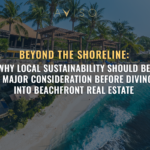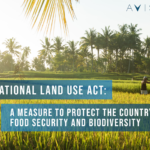
The rapid development of globalization and foreign trade in the country has led to remarkable Economic Achievements. However, economic growth comes with a large amount of energy consumption and carbon emissions, resulting in serious environmental impacts. With the constant increase in carbon footprints, global warming, and other climate issues, environmental degradation became more evident.
According to World Health Organization’s health and environment scorecard, the country records an annual mean of 24 micrograms per cubic meter (µg/m³) for fine particulate matter, significantly surpassing the recommended maximum level of 5 µg/m³. Other recorded surges in air pollution outside Metro Manila include the San Fernando City Station in Pampanga, Antipolo City Station, Biñan City Station, Puerto Princesa City Station, and the Davao City Station.
In a bid to enhance the protection of environment, people’s lives, and property, the government has increased its efforts to combat climate change and foster climate resilience among communities across the country. As part of its commitment to the Paris Agreement on Climate Change, the Philippines has pledged to reduce its emissions by up to 75% til 2030.
The Paris Agreement was adopted by 196 nations that participated in the 21st Conference of the Parties to the UN Framework Convention on Climate Change, which was held in France in December 2015. Generally, the agreement aims to “strengthen the global response to the threat of climate change by keeping the global average temperature rise this century to well below 2 degrees Celsius.”
The sectors of Energy, Transportation, Real Estate, and Construction were anticipated to contribute to the planned reduction.
What is the role of the Real Estate and Construction sector?
The real estate sector will have a significant role in the reduction of carbon emissions over the next decade. According to a report of World Economic Forum (WEF), the real estate sector is one of the main contributors to as emissions.
Over 40% of the global energy is being consumed by the real estate sector annually, and about 20% of the total greenhouse gas emissions come from buildings. By 2030, building gas emissions are expected to increase by 56%, and the global share of raw materials used in construction is expected to be around 40%.
The WEF report also stated that the environmental impact of the real estate sector will become even more serious in the future due to global socioeconomic forces. Most projections indicate that by 2030, the global population will exceed 8 billion and over 60% of the world’s population (4.9 billion people) will be living in urban environments.
This would lead to a substantial increase in construction volumes and real estate market demand. Since the largest 750 cities which account for 61% of the global economy will require to build 260 million new homes, and 540 million sqm of new office space.
Green Building as a Sustainable Initiative
A Green Building can be conceptually defined as a tool for enhancing a building’s resource efficiency, such as its use of energy, water, and materials while minimizing its negative effects on the environment and human health.
According to the U.S. EPA, “green building is the act of creating structures and utilizing forms that are naturally dependable and asset effective all through a building’s life-cycle from siting to plan, development, activity, support, remodel and deconstruction”. , and waste reduction. Green building promotes waste minimization, recycling, and water conservation as well as other social and economic advantages.
In the Philippines, there has been a long expanding movement towards “green” practices, which are aimed at ensuring the environmental sustainability of structures and communities. Numerous buildings in the country have either achieved or are working toward securing dual green building certification from the United States Green Building Council’s Leadership in Energy and Environmental Design (LEED) program, as well as from the Philippine Green Building Council’s Building for Ecologically Responsive Design Excellence (BERDE) program.
Green infrastructure is also categorized as a method towards land use to address the social, environmental, and economic issues. In order to create the ideal ecosystem within an urban area, a network of natural and semi-natural areas along with other environmental features has been carefully planned and constructed. Green infrastructure typically consists of parks, gardens, grassy verges, green walls or roofs, green buildings, tree plantations alongside roads, and the creation of tree belts in suitable locations. Besides these green urban elements, blue urban elements are equally considered in the case of aquatic ecosystems available in an urban area.
Cities, communities, and neighborhoods around the globe can benefit from green buildings, such as those that are LEED certified. The tangible advantages may not be immediately recognizable to tenants or visitors but through sustainable design, construction, and operations.
The building and construction sector anticipate that majority of the projects will be green buildings in the next three years. Looking ahead, creating spaces that support our health and well-being, as well as the economy and environment will be vital to accelerating sustainable development and delivering a better standard of living.
Profitable, cost-effective, and beneficial to the economy
- Client demands, healthier buildings, and financial advantages are the top drivers of green buildings. In new green buildings and green retrofits, operating cost savings, shorter payback periods, and increased asset value have been consistently reported.
- A growing number of building owners reported saw an asset value increase of 10% or more as a result of making an upfront investment in green buildings.
- Green buildings reduce day-to-day costs year-over-year. Compared to typical commercial buildings, LEED buildings have reported almost 20% lower maintenance costs. Green building retrofits typically decrease operation costs by almost 10% in just one year.
Prioritizing people’s health and well-being
- According to US Green Building Council public opinion research, nearly one-third of respondents have direct personal experience with bad health associated with poor environments or living situations. People spend about 90% of their time indoors and green buildings create spaces that promote health and comfort.
- Green buildings have a positive impact on public health. Improving indoor air quality can reduce absenteeism and work hours affected by asthma, respiratory allergies, depression, and stress and self-reported improvements in productivity. Employees in LEED green buildings are reportedly being happier, healthier, and more productive.
- Green buildings promote resilience-enhancing designs, technologies, materials, and methods. It also promotes the use of durable materials, thoughtful site selection, rainwater collection, demand response, grid islanding, energy efficiency, onsite renewable generation, and more.
An environmental solution
- Green buildings help reduce carbon, water, energy, and waste. It has been observed that CO2 emissions from LEED-certified buildings were 34% lower, they used 25% less energy and 11% less water, and they diverted more than 80 million tons of waste from landfills.
- Heating and cooling account for about 43% of all energy use, which contributes to air pollution and generates the largest amounts of greenhouse gases. By improving energy efficiency, green buildings also help reduce indoor air pollutants related to serious health issues.
- Millions of tons of materials globally are being used and wasted in standard building practices annually, compared to the green building which uses fewer resources and minimizes waste. LEED projects are responsible for diverting more than 80 million tons of waste from landfills, and by 2030 that number is expected to grow to 540 million tons.
The general perception of implementing a green strategy is both expensive and complex is a major challenge in the Philippine Market. However, modern technology has simplified and reduced the cost of greening for new and existing buildings. In order to demonstrate this, EDGE has launched several demonstration projects. These projects convinced numerous land developers, including those in the low-cost housing and industrial segment, to adopt green technologies.
Albeit the greening of the real estate industry has begun, there is still much work to be done and the Government’s participation is vital. Policymakers should make mandatory provisions under their legislative framework to develop green buildings in the urban planning process and incentivize the greening of the property sector. Indeed, to meet our commitment to reduce carbon emissions by 75%, there is still much work to be done.
Written By Mary Grace Ladringan
Aviso Valuation and Advisory Corp. is a real estate consultancy firm that offers valuation and business advisory services compliant to international standards such as the International Valuation Standards (IVS) and International Financial Reporting Standards (IFRS). To assure that we only produce high-quality deliverables, as needed, we do tasks beyond the usual appraisal process like verifying pertinent property documents (i.e. land titles, tax declarations, etc.) with the appropriate government agencies for due diligence purposes prior to the acquisition of the properties.
_________________________________________
References:
https://business.inquirer.net/225600/property-firms-climate-change
https://www.usgbc.org/press/benefits-of-green-building
https://business.inquirer.net/225600/property-firms-climate-change









